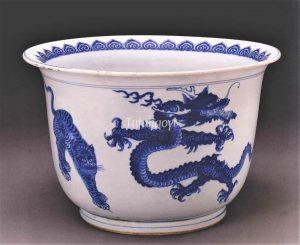Five Supernatural Beasts
五灵
© Tutuhaoyi.com owns the copyright of the description content for the images attached. Quoting all or part of the description content on this page is permitted ONLY IF ‘Tutuhaoyi.com’ is clearly acknowledged anywhere your quote is produced unless stated otherwise. (本页描述内容版权归Tutuhaoyi.com所有,转发或引用需注明 “Tutuhaoyi.com”, 侵权必究, 已注开源信息的条目除外。)
The ‘five supernatural beasts’ include the dragon, the phoenix, the tiger, the qilin and the tortoise. This notion was found to be first mentioned by Du Yu 杜预 (222–285), a third-century Confucian scholar. He annotated the ancient Chinese chronicle Spring and Autumn Annals (春秋 Chunqiu) with The Commentary of Zuo (左传 Zuo zhuan), a collection of historical events ranging from 722 to 468 BCE. In his preface to his new book (杜预《春秋左氏传》序), Du Yu noted, ‘The “Five Supernatural Beasts (五灵 wu ling)” including the qilin unicorn and the feng phoenix are good omens for the king and the powerful (麒凤五灵,王者之嘉瑞也)’.
Kong Yingda (孔颖达 574–648), a later commentator of Du Yu’s book, matched each member of this group to Wuxing (五行), or a fivefold conceptual scheme in Chinese philosophy, and five directions (including the starting point: the middle), following the Han-dynasty (206 BCE – 220 CE) tradition: long-dragon for the east and wood, feng-phoenix for the south and fire, qilin for the middle and earth, white tiger for the west and metal, and divine tortoise for the north and water.
Kong Yingda’s book, Correct Meaning of The Commentary of Zuo (左传正义 Zuo zhuan zhengyi) was adopted as the standard textbook for the civil-service examinations in China for nearly a millennium and remained to be the basis for all following scholarly commentaries of the classic Spring and Autumn Annals and The Commentary of Zuo. The conventional notion of the ‘Five Supernatural Beasts’ mentioned in his book thus remained to be influential because of the authority of Du Yu’s book among the Chinese literati.
image identification and literature research by Dr Yibin Ni
Read Dr Ni’s blog here to see how this theme was misinterpreted in contemporary books.
Fig 1: porcelain dish with underglaze blue decoration, Kangxi period (1662–1722), Qing dynasty, courtesy of the Palace Museum, Beijing
Fig 2-3: porcelain flower pot with underglaze blue decoration, Kangxi period (1662–1722), Qing dynasty, courtesy of the Palace Museum, Beijing
Fig 4: woodblock printed illustration of ‘Five Divine Creatures’, from Master Fang’s Ink-Cake Album (方氏墨谱 Fang shi mo pu), 1589



